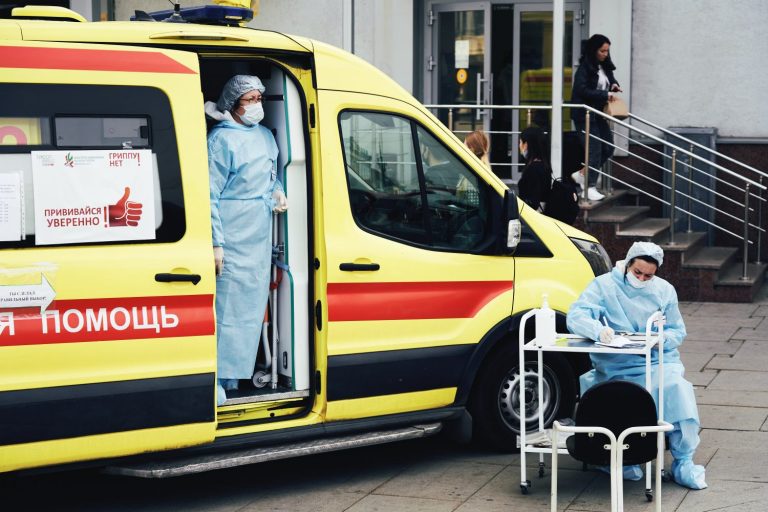Photo by Maxim Tolchinskiy on Unsplash
What can the vaccine roll-out learn from test and trace?
By John Atkinson and David Nabarro. Originally published in the MJ on 25 January 2021.
Hospitals across the country are reporting conditions that are urgent and serious. Pressure in hospitals is always an indicator of pressure throughout systems of health and care. In hospitals where people in the most serious of conditions are all in the same place, the challenges faced are acute. At the same time, people and services are strained in the care provided for people at home, in residential care, through General Practice, by the ambulance services. This tests the limits of capacity at a critical moment in the country’s efforts to come to terms with COVID-19.
A lot is expected of vaccination. By starting with vaccinations for the elderly and most vulnerable, lives will be protected. This will reduce the pressure involved in acute health care. Those most at risk of severe and life-threatening symptoms will gain a measure of safety. It will be some months before a sufficient proportion of the wider population has been vaccinated and there will be sufficient population immunity to reduce incidence of new cases. This may not be straightforward if variants of the virus continue to emerge at intervals and some are capable of causing disease in vaccinated individuals. The vaccines may need to be adapted so as to be able to contain them, and then re-administered. Another reason for revaccination is a possible limitation in the duration of immunity following infection or vaccination.
It is vital to apply the lessons we are learning as the pandemic continues to unfold. The strands of the nation’s response need to remain connected, retain their emphasis, and be implemented as effectively as possible. Basic public health messages that shape population behaviour need to be clear and consistent. Testing needs to result in tracing and effective isolation. Vaccination needs to reach the people who need it most; particularly the elderly and vulnerable.
Are there lessons for the vaccination process from test and trace? Test and trace focused on a large scale, nationally directed approach. Where such approaches work, and work well, they enable considerable volumes of people to be reached in short timeframes. Where national approaches are more challenged is in reaching specific communities sufficiently quickly, particularly more deprived communities. People on erratic patterns of employment and thus income, living in low quality housing, need a wrap-around of support if they are to be able to isolate when contacted. The centralised approach to test and trace takes time to get to these communities, doesn’t necessarily provide what is needed for people to help them effectively isolate, and this can lead to difficulty with interrupting transmission and suppressing clusters.
It is important that take-up of the vaccination programme is high in the areas of our towns and cities where the virus is widespread and is proving stubborn to suppress. If the vaccination programme is to move quickly and in the most effective manner, there is clear learning to take on board. A nation-wide and well-planned approach is essential as it is able to scale-up rapidly. It must be embraced by groups who may be harder to reach. Local operators know these groups already and have many avenues to reach them. If the national programme connects well to local authorities, then targeted approaches can connect communities effectively with the facilities that are made available.
To learn the lessons from earlier phases of the pandemic means that a multi-level approach to vaccination can be helpful.
It starts with the scale and capacity of national approaches which should be fully exploited. Alongside the scale, there is a need for precision. Local government is the critical layer in getting this right.
With the unique relationships local government holds, both with national and regional organisations, as well as with particular communities, it can play a vital role in connecting groups with varying needs. As local government connects with the honeycomb of faith, sporting, business, and geographic organisations, be they commercial, voluntary or the local part of the larger national infrastructure, it is able to access their collective intelligence and be much more effective at reaching people in greatest need. The selection of vaccination sites, the messages that are crafted and the means through which those messages are passed on, leads to a programme that is more likely to reach those at greatest risk and who need vaccination early.
This is all about tapping into local know-how about how to get things done. If knowledge is about what needs to be done, that is not enough. What is really helpful is know-how; ways to get it done, right here, right now, in this place. While national debates may rage on the efficacy of testing, the nature of new strains of the virus, or the components of the vaccination strategy, it is the know-how of local government that has kept a focus on what is needed in their places and sharpened the effectiveness of each intervention.
It is this know-how of the stakeholders who are active in local government, often unseen and unheard, that continues to play a vital role in suppressing the virus. As COVID-19 continues to swirl, spike and surge around the country, it is vital that the learning from test and trace is carried forward into the vaccination programme. This will balance the need to reach high volumes of people with know-how on how best to reach those who live and work in a wide variety of settings. Local government’s capacity to connect, convene and communicate locally will be critical.


Leave a Reply
Want to join the discussion?Feel free to contribute!